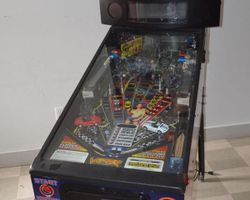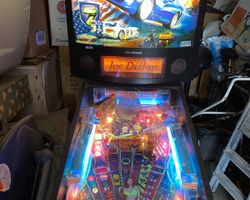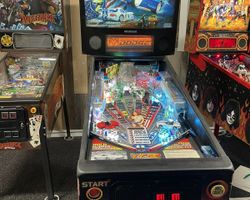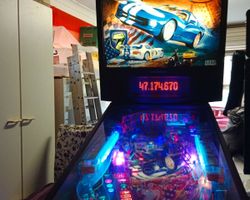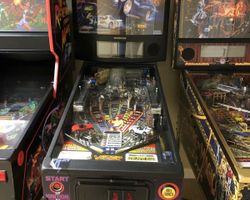Viper Night Drivin'
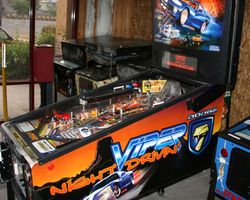
Average Prices: USD $1,100 to $2,400
Produced: 1998
Production Run: 1,100 units
Machine Type: Solid State Electronic
MPU: Sega/Stern Whitestar
Players: 6
Concept by: Joe Kaminkow, Rob Hurtado
Design by: Rob Hurtado
Art by: Morgan Weistling
Dots/Animation by: Kurt Andersen
Mechanics by: Rob Hurtado
Music by: Slash, Saul "Slash" Hudson
Sound by: Kyle Johnson
Software by: Neil Falconer, Orin Day, Lonnie D. Ropp
Viper Night Drivin' stands as a distinct entry in the pantheon of pinball machines from the late 1990s, emerging from the innovative studios of Sega Pinball, Inc. in 1998. This solid-state electronic pinball machine, bearing the model number 35, plunged players into the high-octane world of night racing, deeply rooted in the imagery and allure of the Dodge Viper sports car. The game's genesis was a collaborative effort, with Joe Kaminkow conceptualizing the core idea, which was then brought to life by designer Rob Hurtado, who also handled the mechanical engineering. The visual identity of the pinball machine was shaped by artist Morgan Weistling, while Brian Schmidt composed the musical score and sound design. Notably, the game's soundtrack features guitar contributions from Slash, recognized for his work with Guns N' Roses, providing a pulsating auditory backdrop. The software, the intricate brain of the machine, was developed by Jon Norris, Lonnie D. Ropp, Neil Falconer, and Orin Day, with Kurt Andersen handling animations for the Dot Matrix display. Released on January 1st, 1998, Viper Night Drivin' had a production run of approximately 1,100 units, making it a relatively rare machine within the Sega Whitestar generation of pinball tables. A unique piece of trivia for this pinball machine is its early adoption of Day-Glo technology within the pinballs themselves, allowing them to visibly glow under the integrated black lights—a feature Big Bang Bar had previously used, but Viper Night Drivin' arguably integrated to a greater visual effect, especially for its night racing theme.
Signature Features and Design
Viper Night Drivin' distinguishes itself through several signature elements that are integral to its thematic presentation and gameplay experience. Central to its identity are the three integrated black lights, which can be configured to activate during specific features or remain constantly illuminated. These lights transform the playfield's aesthetic, particularly when combined with the four specialized "Glo-Balls" that ship with the machine. Unlike traditional steel pinballs, these plastic Glo-Balls are designed to light up vividly under the black light, creating a striking visual effect that reinforces the "Night Drivin'" aspect of the theme. For operators or owners, an option exists within the software to use conventional steel pinballs, though this diminishes the machine's unique visual spectacle.
Beyond the lighting, the playfield is adorned with various thematic toys and mechanisms. Two miniature Dodge Viper cars are strategically placed above the slingshots, enhancing the racing theme. The "Devil's Tower" is another prominent playfield toy, adding an element of mystery or challenge to the layout. Animated raccoons are cleverly integrated, appearing in certain playfield areas to provide dynamic visual feedback. An up-post positioned between the flippers serves as a ball-saving mechanism, activated by a dedicated button on the machine's front. The game also incorporates custom speech, which, while adding character, notably features the divisive presence of radio personality "Mancow," a detail that has garnered varied reactions from players. Furthermore, a "Modesty Feature" allows operators to adjust video graphics, sound, and language content for different audiences, a forward-thinking design choice for its time. For multiplayer experiences, a "Team Play" feature is available for four-player games, displaying individual scores alongside combined team totals, fostering a cooperative competitive dynamic.
Playfield and Mechanics
The playfield of Viper Night Drivin' is a testament to Rob Hurtado's design philosophy, embracing a fast and fluid layout that encourages continuous action. It features a conventional fan layout, presenting players with multiple shot opportunities that often cycle the ball back to the flippers for sustained play. Dominating the upper playfield are three distinct ramps, each offering a different trajectory and scoring potential, crucial for advancing through objectives. Below these ramps, three pop bumpers add chaotic energy to the ball's movement, while two slingshots propel the ball back into play with force. Five standup targets are strategically placed, requiring precision shots to activate various game features or score points.
Two vertical up-kickers are integrated into the playfield, launching the pinball into upper areas or specific modes. The overall flow of the playfield is designed for speed, with shots often returning quickly, contributing to a sense of urgency akin to a high-speed race. Morgan Weistling's artwork complements this dynamic, depicting a gritty, urban night scene, with dark tones providing a stark contrast to the vivid glow of the Glo-Balls and black lights when activated. The Dot Matrix display provides real-time feedback and animations, including a "Drag Racing Driving game" video mode, seamlessly integrating into the racing narrative. The interaction between the Glo-Balls and the black lights is a mechanical highlight, creating a compelling visual spectacle, particularly during the ultraviolet-lit multiball phases, where the entire playfield seems to pulsate with energy.
Gameplay Dynamics
Viper Night Drivin's gameplay dynamics are focused on delivering a rapid, engaging experience, though opinions on its rule depth vary. The core progression revolves around hitting specific shots to activate modes and build towards multiball. The game supports a 4-ball multiball, a chaotic and visually impressive event when the Glo-Balls are in play under the black lights. While some players find the objectives straightforward, others appreciate the game's emphasis on shot accuracy and ball control to achieve high scores. The playfield's design, with its multiple ramps and return paths, facilitates a fast pace, rewarding players who can consistently chain shots.
Beyond standard scoring, the machine incorporates unique challenges and features. The video mode transforms the Dot Matrix display into a drag racing mini-game, providing a brief respite from the main playfield action while still aligning with the overall theme. The center post, activated by a button on the coin door, offers a last-ditch effort to save a draining ball, adding a strategic element to crucial moments. The game's software allows for different game types such as Replay, Novelty, 4-Ball, or Add-A-Ball, offering flexibility in how the game is experienced. While the rules may not be as layered as some contemporary pinball machines, the excitement largely stems from the sensation of speed and the unique visual presentation during its most intense moments, particularly the black light multiball, which is a signature experience of the machine.
Reception and Legacy
Viper Night Drivin' has cultivated a mixed yet largely positive reception within the pinball community, often being considered an overlooked or underrated machine, especially by enthusiasts of Sega's Whitestar era. Its primary strength lies in its distinctive visual experience. The innovative use of black lights combined with the specialized Glo-Balls creates a light show that is consistently praised as impressive and unique, particularly when the game is played in a dimly lit environment. This visual flair, especially during the UV/black light multiball, is frequently cited as a major draw and a memorable highlight. Players also commend the game's fast gameplay and smooth flow, noting that when the machine is properly maintained and "dialed in," it delivers an exhilarating and high-adrenaline experience with quick shots returning to the flippers. The inclusion of Slash's guitar riffs in the soundtrack is another frequently lauded aspect, contributing to the game's energetic atmosphere. For automotive enthusiasts, especially those with an affinity for the Dodge Viper, the theme and detailed artwork are significant attractive features. The machine's rarity, with only around 1,100 units produced, also enhances its appeal to collectors.
However, Viper Night Drivin' is not without its criticisms. The most significant point of contention revolves around the Glo-Balls themselves. While visually stunning, their lighter plastic construction often impacts ball physics and control, leading to unpredictable bounces, accidental drains, or balls jumping over features. The scarcity and high cost of replacement Glo-Balls also present a practical challenge for owners. Many players opt to replace them with traditional steel balls, sacrificing the unique visual effect for more predictable gameplay. The inclusion of the "Mancow" radio personality's voice clips is almost universally disliked, often described as awkward or irrelevant to the racing theme. Rule depth is another common criticism; some players find the objectives and scoring progression to be shallow or less engaging compared to more complex machines, leading to a perception of repetitiveness. The playfield layout, while fast, is sometimes seen as generic or overly tight, with a lack of variety in shots. Drains, particularly from the pop bumpers, can be frequent, disrupting the flow. Furthermore, the game's reliance on a dark environment for its full visual impact means that its appeal can be diminished in brightly lit arcade settings.
Despite these criticisms, Viper Night Drivin' maintains a unique place in pinball history due to its pioneering integration of lighting technology. While Big Bang Bar predated it in using Day-Glo materials and black lights, Viper Night Drivin' arguably brought the concept to a wider audience and tied it more directly into the core theme. Its legacy is primarily defined by this visual innovation and its status as a distinct product from Sega Pinball. It stands as an example of late 90s design that prioritized a striking, immersive experience, influencing the ongoing exploration of integrated lighting effects in pinball machine design.
Sponsored Links
 Ebay Listings
Ebay Listings
 Auction Results
Auction Results
| Cost | Location | Date |
|---|---|---|
| EUR €2,700 |  Nordrhein-Westfalen, Germany Nordrhein-Westfalen, Germany |
11 September, 2024 |
| USD $5,500 |  California, United States California, United States |
15 September, 2023 |
| GBP £2,260 |  Skegness, United Kingdom Skegness, United Kingdom |
27 June, 2022 |
| AUD $5,350 |  Queensland, Australia Queensland, Australia |
18 March, 2022 |
| USD $5,500 |  Indiana, United States Indiana, United States |
14 February, 2022 |
| USD $4,000 |  Florida, United States Florida, United States |
12 February, 2022 |
| EUR €7,099 |  Thüringen, Germany Thüringen, Germany |
06 January, 2022 |
| USD $2,200 |  Indiana, United States Indiana, United States |
21 November, 2020 |
| USD $3,000 |  Florida, United States Florida, United States |
19 October, 2020 |
| EUR €2,990 |  Nordrhein-Westfalen, Germany Nordrhein-Westfalen, Germany |
29 October, 2019 |


Private Policy · Search Website · Contact Us
As an eBay Partner, we may earn a commission from qualifying purchases made through links on this site, at no additional cost to you.
All trademarks and copyrighted materials remain property of their respective owners. All other content copyright 2007 - 2026 Pinpedia.

